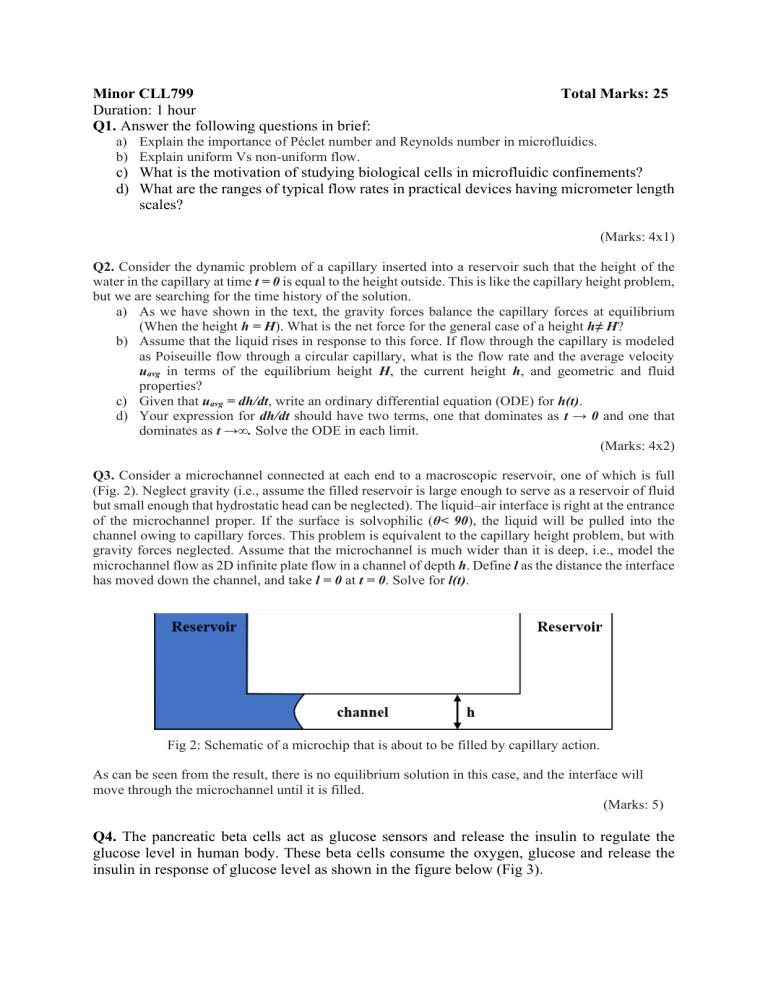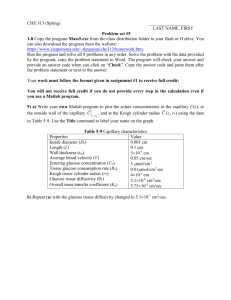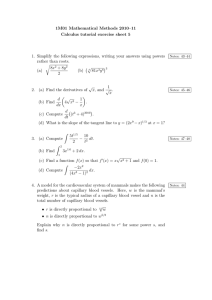
Minor CLL799 Duration: 1 hour Q1. Answer the following questions in brief: Total Marks: 25 a) Explain the importance of Péclet number and Reynolds number in microfluidics. b) Explain uniform Vs non-uniform flow. c) What is the motivation of studying biological cells in microfluidic confinements? d) What are the ranges of typical flow rates in practical devices having micrometer length scales? (Marks: 4x1) Q2. Consider the dynamic problem of a capillary inserted into a reservoir such that the height of the water in the capillary at time t = 0 is equal to the height outside. This is like the capillary height problem, but we are searching for the time history of the solution. a) As we have shown in the text, the gravity forces balance the capillary forces at equilibrium (When the height h = H). What is the net force for the general case of a height h≠ H? b) Assume that the liquid rises in response to this force. If flow through the capillary is modeled as Poiseuille flow through a circular capillary, what is the flow rate and the average velocity uavg in terms of the equilibrium height H, the current height h, and geometric and fluid properties? c) Given that uavg = dh/dt, write an ordinary differential equation (ODE) for h(t). d) Your expression for dh/dt should have two terms, one that dominates as t → 0 and one that dominates as t →∞. Solve the ODE in each limit. (Marks: 4x2) Q3. Consider a microchannel connected at each end to a macroscopic reservoir, one of which is full (Fig. 2). Neglect gravity (i.e., assume the filled reservoir is large enough to serve as a reservoir of fluid but small enough that hydrostatic head can be neglected). The liquid–air interface is right at the entrance of the microchannel proper. If the surface is solvophilic (θ< 90), the liquid will be pulled into the channel owing to capillary forces. This problem is equivalent to the capillary height problem, but with gravity forces neglected. Assume that the microchannel is much wider than it is deep, i.e., model the microchannel flow as 2D infinite plate flow in a channel of depth h. Define l as the distance the interface has moved down the channel, and take l = 0 at t = 0. Solve for l(t). Fig 2: Schematic of a microchip that is about to be filled by capillary action. As can be seen from the result, there is no equilibrium solution in this case, and the interface will move through the microchannel until it is filled. (Marks: 5) Q4. The pancreatic beta cells act as glucose sensors and release the insulin to regulate the glucose level in human body. These beta cells consume the oxygen, glucose and release the insulin in response of glucose level as shown in the figure below (Fig 3). Fig 3 The oxygen and glucose reaction/consumption rate can be modeled as generalized MichaelisMenten kinetics (Sigmoid, Hill response) as shown in figure 3. For a perifusion experiment, a single beta cell is kept in a microchannel and the glucose, oxygen and nutrients are pumped at the inlet as shown in figure 4. Fig 4 Model the Glucose-stimulated insulin secretion in isolated pancreatic beta cell inside this microchannel for flow condition. You can take initial concentration of glucose and oxygen as constant at the microchannel inlet. (Marks: 8)



